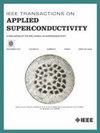HTS固定磁悬浮列车悬浮体失效动力学分析
IF 1.7
3区 物理与天体物理
Q3 ENGINEERING, ELECTRICAL & ELECTRONIC
引用次数: 0
摘要
高温超导(HTS)固定磁悬浮(磁悬浮)车辆技术提供稳定的悬浮和引导,没有主动控制或定向磁阻,为铁路运输领域提供了突破性的解决方案。然而,在车辆运行过程中,高温超导体对临界电流、磁场和温度的变化很敏感,可能导致悬浮体故障。本文研究了这些故障如何影响HTS固定磁悬浮车辆的动力学。首先,通过分析高温超导体失去超导性时悬浮力的衰减,推导出悬浮力衰减模型。利用该模型,建立了考虑悬浮体失效的磁悬浮车辆动力学模型。最后,我们分析了涉及一个或多个悬浮体故障的车辆动力学。我们的研究结果表明,当一个levitator转向架角落失败时,车辆的最低悬浮高度减少从8.78毫米到5毫米,最大横摇角达到0.09 $ ^{\保监会},美元和偏航角最大达到0.16 $ ^{\保监会}$。4个转角悬浮体均失效时,最小悬浮高度由8.78 mm降至5.22 mm,最大滚转角为0.03$^{\circ}$,最大偏航角为0.04$^{\circ}$。这些结果为确保未来高速列车的安全性提供了有价值的信息。本文章由计算机程序翻译,如有差异,请以英文原文为准。
Dynamic Analysis of Levitator Failure in HTS Pinning Maglev Vehicle
High-temperature superconducting (HTS) pinning magnetic levitation (maglev) vehicle technology offers stable levitation and guidance without active control or directional magnetoresistance, offering a groundbreaking solution for the rail transport sector. However, HTS bulks are sensitive to changes in critical current, magnetic field, and temperature during vehicle operation, potentially leading to levitator failure. This article examines how such failures affect the dynamics of an HTS pinning maglev vehicle. First, we derive a model of levitation force decay by analyzing the reduction in levitation force when HTS bulks lose superconductivity. Using this model, we then develop a dynamic model of the maglev vehicle that accounts for the levitator failure. Finally, we analyze vehicle dynamics in scenarios that involve one or multiple levitator failures. Our findings indicate that when a single levitator at a bogie corner fails, the vehicle's minimum levitation height decreases from 8.78 mm to 5 mm, the maximum roll angle reaches 0.09$^{\circ }$ $^{\circ }$ $^{\circ }$ $^{\circ }$
求助全文
通过发布文献求助,成功后即可免费获取论文全文。
去求助
来源期刊

IEEE Transactions on Applied Superconductivity
工程技术-工程:电子与电气
CiteScore
3.50
自引率
33.30%
发文量
650
审稿时长
2.3 months
期刊介绍:
IEEE Transactions on Applied Superconductivity (TAS) contains articles on the applications of superconductivity and other relevant technology. Electronic applications include analog and digital circuits employing thin films and active devices such as Josephson junctions. Large scale applications include magnets for power applications such as motors and generators, for magnetic resonance, for accelerators, and cable applications such as power transmission.
 求助内容:
求助内容: 应助结果提醒方式:
应助结果提醒方式:


